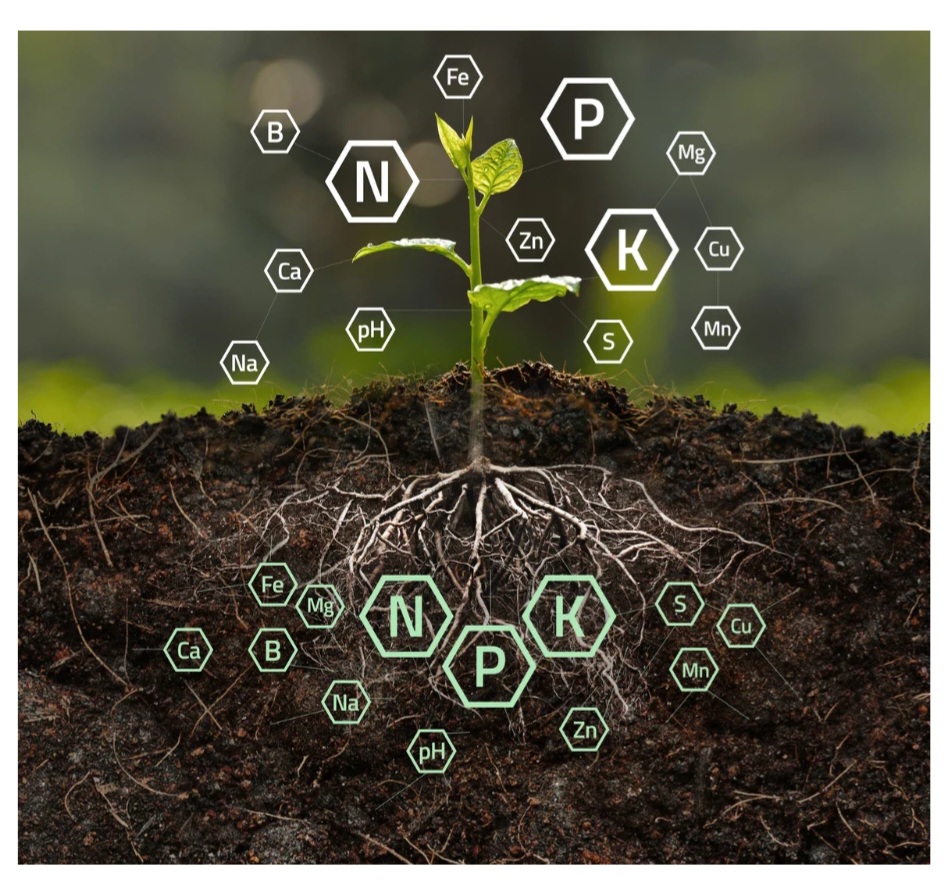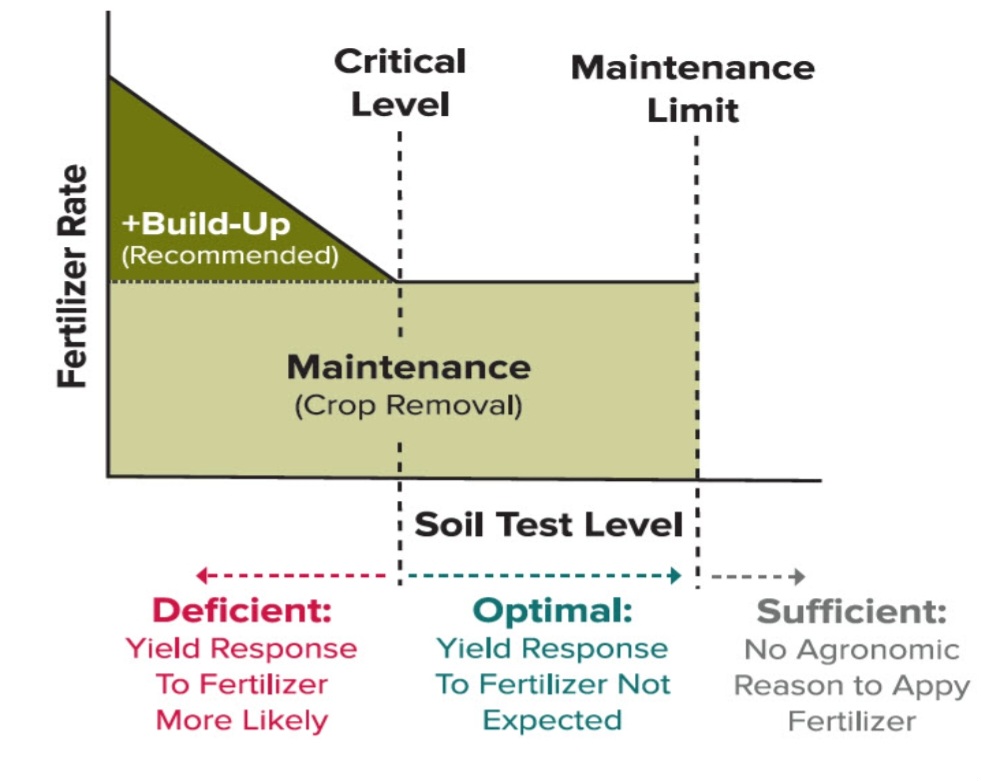
Soil can be thought of as the reservoir of most of the essential elements for plant growth. The soil supplies 13 elements out of the 16 essential elements required for nutrition of these higher plants. The 13 elements are taken up by plants only in mineral forms from the soil. These elements are divided into macro nutrients and micro nutrients.The macro nutrients such as Nitrogen, phosphorus and potassium are refered to as primary macro nutrients, while calcium, magnesium and sulfur are refered to as the secondary macro nutrients. The micronutrients ( trace elements) such as boron, copper, chlorine, iron, manganese, molybdenum and zinc occur in very small amount in both soils and plants, but their role is equally as important as the primary and secondary macro nutrients. A deficiency of one or more of the micronutrients can lead to severe depression in growth, yield and crop quality. Some soils do not contain sufficient amount of these nutrients to meet the plant’s requirement for rapid growth and good production. In such cases, supplemental nutrient application as fertilizer should be done. All these elements required for nutrition of higher plants must be available continuously and in balanced proportion to support photosynthesis and other metabolic processes in the plants. If any one of these essential elements is missing, plant productivity will be limited or the plant may cease to grow entirely.Different soils have varying nutrients supplying power depending on the amount of total reserves on mobilization and accessibility of the chemically available nutrients to plant roots. The process of determining the nutrient status of soil or their capacity for providing nutrients in order to guide effective fertilizer application can be refered to as soil fertilizer assessment / evaluation.
SOIL FETILITY EVALUATION TECHNIQUES. These are methods available to assess the fertility status of the soil. Such methods include: soil analysis, plant tissue analysis and visual symptoms observation of nutrient deficiencies. Both soil and plant tissue analysis are carried out in the laboratory after collection of samples from the field.
STEPS TAKEN IN SAMPLE ANALYSIS. i. Sample collection from the field ( whether plant or soil samples) ii. Sample preparation, processing and storage. iii. Analysis of materials using chemicals ( extractant or digestion) iv. Interpretation of analytical results. And. v. Fertilizer recommendation.
Soil and plant analysis are diagnostic tools to determine the amount of nutrients in soils and plants. These elements are usually solubulized by suitable extractants in soil and digest in plant, and the quantities of these elements in the extract and digest are determined by using appropriate methods and equipments. The data obtained from the analysis are interpreted to show the deficiency or sufficiency of the nutrients in soil and plant using the critical level of the elements.
CALIBRATING SOIL TESTS( DETERMINATION OF CRITICAL LEVEL AND NUTRIENT ELEMENTS IN SOIL) Soil testing calibration refers to the relationship between soil testing values and yield response due to fertilization. This indicate at which soil test value is crop responses expected.In calibration study, terms like critical, optimal level are used.Before interpretation of soil test result, it is essential that the soil test result ( amount of a nutrient extracted by a given soil test) is calibrated against crop responses from application of nutrients in question. This information is obtained from field and green house fertility experiments conducted over a wide range of soils. Yield responses from the various rates of applied nutrients can then be related to the quantities of available nutrients in the soil, indicated by the soil test. The process of determining the degree of limitation of crop growth or the probability of getting a growth response to an applied nutrient at a given soil test level is known as soil test calibration and must be determined experimentally in the field.A common procedure for calibrating a soil test is to grow the crop on soils respective of where the soil test will be used, covering the range of soil test extractable nutrients likely to be encountered. This must be done for each crop with which the soil test will be carried out. From the result of the experiment, either the yield or the relative yield can be plotted against the amount of extractable nutrient.Many of the testing laboratories classify the fertility level of soil as very low, low, medium, high or very high bases on the comparison of the quantity of nutrient extracted in the soil test with standard values of the nutrients stated in literatures. In general, the very low ( lower limit of sufficiency) or very high classification ( upper limit of sufficiency ranges) is easily understood by the grower. However, crops differ in their requirement, what is low for potatoes may be high for small grains and what is low for a clay loam soil may be high for a sandy loam soil. In any case, it is important that growers of crops should know the meaning of the results of their soil test.
FACTORS AFFECTING SOIL TEST CALIBRATION. Soil fertility is one of the factors influencing plant growth. But in general, there are chances of obtaining response from a given nutrients even when the soil test result is low. Soil test calibration may be complicated by factors influencing the response of crop to fertility level. Such factors like temperature, water, soil properties, cultural practices, varieties and pest are rapidly controlled in green house then on the field. Therefore, controlled experiment were initially conducted in the green house to provide information about: 1. the ability of a soil test extractant to extract a nutrient in quality relates to the amount removed by the plant. 2. the relationship between soil test level , relative yield and critical nutrient range for various crops. 3. the range in soil test levels and crop responsiveness for the major soil types in the region.
After completion of the green house studies, field calibration experiments are conducted on the major soil series and crops in the region. For example, if a phosphorus soil test is being calibrated, 4-6 rates of P will be applied and the crop response quantified by measuring yield and P content in the whole plant or plant parts. The yield response is then plotted against the percentage yield or yield increase. The percentage yield represent the ratio of the yield in the underutilized soil to the yield obtained when P is non limiting ( fertilized soil). This is then multiplied by 100. For example, 70% yield means that the crop yield with the underfertilized soil is 70% of the yield obtained at the optimum level of P. Similarly, yield increase represent the increase in yield obtained with optimum fertilization.
Using an experiment conducted by Tisdale and Nelson in 1993, the graphs below were plotted. The graphs shows expected barley yield to nitrogen and phosphate fertilizer application at different soil test level. Barley respond higher to N and P at their low application rate. While at high application of N and P, barley response was low.

CRITICAL LEVEL.
The critical level (CL) represent the soil test level above which no response to fertilization will be obtained. It can also be degined as the soil test value above which response is not expected and below which a large yield responses can be obtained with adequate supply of plant nutrients. It is used to determine the level at which yield will fall. Soil test critical levels can vary among crops, climatic regions, and extractants.The critical level (CL) of a particular nutrient depend on the soil analytical method, the crops and the response model used.
USES OF CRITICAL LEVELS IN INTERPRETATION OF SOIL TEST RESULT. Soil test interpretation involves economic evaluation of the relation between the soil test value and the fertilizer response. However, the potential response may vary due to several factors, including soil, crop, expected yield, level of management and weather condition.Interpretation of analytical result is used to assess the overall nutrient status of the soil by using the soil test data as guide line to provide fertilizer recommendation. It should be noted that different crops often respond differently to applied nutrients. To interpreted soil test results, the result obtained are compared with established critical levels of the elements in the soil and plants.

